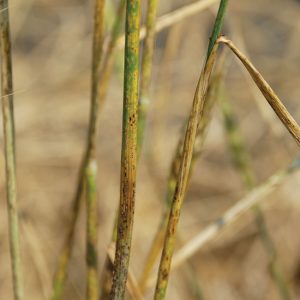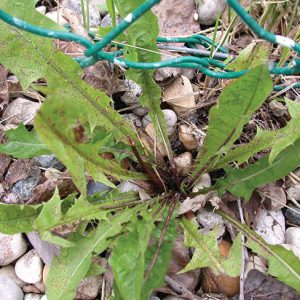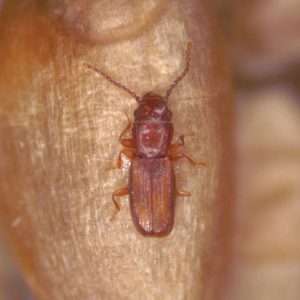
Features
Agronomy
Pests
Strengthening biovigilance
Improving collaboration among researchers, producers and others for tackling Prairie crop pests.
August 24, 2022 By Carolyn King
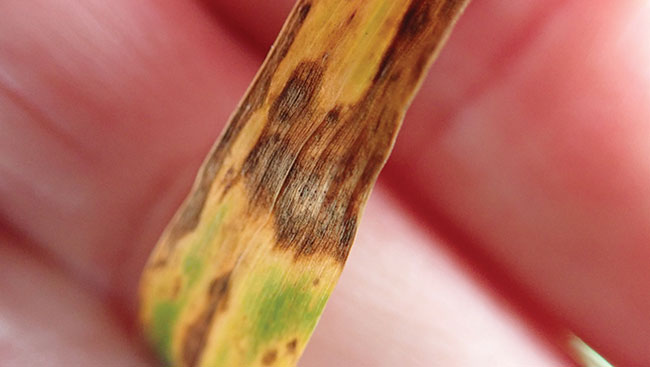 The network has a pilot project to have producers collect pest survey samples on their own farms, including a wheat leaf disease survey.
Photo courtesy of Brent McCallum.
The network has a pilot project to have producers collect pest survey samples on their own farms, including a wheat leaf disease survey.
Photo courtesy of Brent McCallum. If you want to go far, go together. That’s a key concept underlying the Prairie Biovigilance Network (PBN). The PBN is enhancing co-operation among researchers and others active in pest management – including producers – to increase our ability to fight weed, insect and disease pests in western Canadian crops.
PBN project lead Brent McCallum explains that biovigilance is a fairly new term. It refers to a comprehensive continuum that includes: finding and identifying pest problems; assessing and understanding these problems; developing possible solutions; implementing the solutions; and then evaluating how well these solutions work – which starts the cycle again.
Ongoing biovigilance is vital as crop pest populations continually adapt to different control measures, changing agricultural practices and varying climate patterns; as new pests spread into the region; and as our understanding of sustainability issues increases.
The network is a component of Agriculture and Agri-Food Canada’s biovigilance program across Canada. “There are also projects in Ontario and Quebec, and a Coastal Biovigilance Network was recently started,” says McCallum, a plant pathologist with Agriculture and Agri-Food Canada (AAFC) at Morden, Man.
“The PBN currently is a multidisciplinary group of researchers within AAFC. We are mostly from the Prairies, but we have members from across the country.”
He notes that other initiatives like the Prairie Pest Monitoring Network and the Prairie Crop Disease Monitoring Network are working to enhance monitoring within individual pest management disciplines. “With the PBN, we’re trying to do the same sort of thing but for insects, weeds and diseases all together.”
Formed in 2019, the PBN started its formal research project in 2020. The group has already successfully built bridges between the disciplines of weed science, entomology and plant pathology within the PBN. “Working with these people from the different disciplines is great because we can identify areas where we have common challenges,” McCallum says.
The group also wants to connect with the many other organizations and individuals involved in Prairie crop pest work – universities, provincial governments, municipal governments, private research companies, producer groups, and individual producers. Broader co-ordination and co-operation among all these players could help increase efficiencies, prevent gaps, and improve information sharing in Prairie crop biovigilance.
One of the PBN’s first tasks was to identify gaps in biovigilance research for Prairie crops. “To get a really comprehensive picture, you have to work together and get all the information in one place. Then you can identify the gaps. And then you can ask: How could we improve that?” McCallum says.
He adds, “One of our PBN members, Syama Chatterton, gave the example of Aphanomyces root rot to show why it is so important to do pest surveillance constantly. This pulse disease was building up for a few years. However, root rot surveys were only done sporadically in those years. By the time people realized this disease was an issue, it had become a big problem. If you do surveillance every year, you can catch the little problems and start dealing with them before they become serious concerns.”
The network is also filling a couple of gaps in AAFC’s pest surveillance funding: cereal disease surveys; and monitoring for insect pests in stored products. These activities are very important, but no funds were targeted specifically for them, so they are being done as part of the PBN.
As well, the PBN is looking at how to get a new funding structure in place for ongoing surveillance of Prairie crop pests.
Surveillance synergies
As you can see, several of the PBN’s tasks relate to pest surveillance, a catalyst for the rest of the stages in the biovigilance continuum.
Kelly Turkington, an AAFC plant pathologist and PBN member, outlines why pest surveys are so valuable. “These surveys provide strategic information regarding what issues are out in farmers’ fields, what impacts those issues are having, and whether there are shifts in the issues.”
Such information can help producers, crop advisors and others identify emerging concerns that need to be addressed. Turkington gives an example: “On the Prairies over about the past 20 years, there have been some pretty significant shifts in fungicide sensitivity especially in terms of the strobilurin class of fungicides. That means producers, agronomists and the industry need to look at fungicide resistance management strategies so the fungicide’s active remains effective for the longest period of time possible.”
Pest survey findings also help research funding agencies to set priorities and help shape the research programs of weed scientists, pathologists, entomologists and crop breeders.
“For instance, information on shifts in the race structure of a pathogen’s population can give a heads-up to pathologists and crop breeders about whether the pathogen is starting to overcome certain resistance genes in the crop, and whether breeders want to consider using different resistance genes or pyramiding several resistance genes together in a particular variety.”
The PBN is looking for synergies in pest surveillance that can help with common challenges across disciplines and organizations.
One such challenge is field access. McCallum explains, “New trespassing laws have been put into place so the requirements have become much stricter in terms of getting permission from producers to enter their fields.”
Interestingly, some organizations have found a way to obtain these permissions that could work well for both producers and researchers. For example, Saskatchewan Agriculture’s website has a page where interested Saskatchewan crop growers can voluntarily sign up for crop pest surveillance in their fields.
Saskatchewan Agriculture shares this sign-up list with its partners in pest monitoring in Saskatchewan, such as AAFC, the University of Saskatchewan, crop producer groups, and others. All the partners follow strict biosecurity protocols to prevent the introduction of crop pests into farmers’ fields while surveying. And all partners keep producer identification, land location and contact information confidential.
McCallum thinks such consent-based systems might be the way of the future for pest surveillance.
Producer pilot project
The PBN initiated a pilot project in 2021 to evaluate the possibility of having producers collect pest survey samples on their own farms.
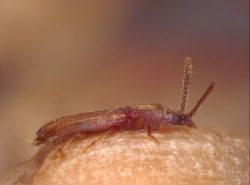
The producer pilot project also includes a stored-grain insect survey.
Photo courtesy of Agriculture and Agri-Food Canada.
“Often producers are the ones who spot pest problems first and alert the researchers that there is a problem with, for instance, a new disease or insect in their area, a change in pest populations, or a change in the effectiveness of a control treatment,” McCallum notes.
“So, producers are already involved in this type of work, and we’re hoping to tap into that.”
This pilot project offers a good opportunity for producers to learn more about their own pest situation, and for AAFC researchers to engage with producers and to extend the reach of pest surveillance. McCallum says, “Although researchers are able to do some of this critical surveillance work, they cannot adequately cover all the fields and farms in the Prairies.”
The pilot includes a wheat leaf disease survey and a survey of stored-grain insects in grain bins.
Farmer collaborators are sent sampling kits and instructions, along with pre-paid, addressed envelopes to send their samples to AAFC. AAFC analyzes the samples.
The collaborators receive the results for their own samples as well as a summary of results for the Prairies so they can see how their farm’s results compare.
All information identifying specific producers and locations is kept strictly confidential.
Straightforward sampling
Turkington is leading the leaf disease survey, and Vincent Hervet, an AAFC entomologist, is leading the insect survey. They have developed the sampling kits and procedures to try to minimize the time and effort producers would need to put into the sampling.
“We appreciate that farmers have an extremely busy summer with multiple issues on their plate, and we’re very grateful for the collaboration that we get,” Turkington says.
The wheat leaf kit is based on a kit that Turkington developed for a similar type of survey in the early 2000s. In that three-year joint project between his research group and Alberta Barley, farmers collected barley leaf samples and AAFC analyzed the samples. One of the challenges was to get sufficient numbers of producers to collect samples.
Turkington emphasizes you don’t need any special knowledge of wheat diseases to take part in the pilot. In fact, the idea is to select wheat plants at random and collect samples of their leaves, rather than targeting diseased plants. “We want representative samples so we can get a good estimate of the average level of disease in the field and what diseases are present.”
The field sampling normally requires no more than 30 to 60 minutes, and you do it only once in the growing season, usually at the late milk or early dough stage. You are also asked to provide background information about the sampled field, but that can be done back in the office.
The PBN pilot is the first time that AAFC has asked producers to survey for stored-grain insects. Along with the instructions, a form for information about the sampled bins, and the return envelope, the kit includes two grain probe traps, so you can sample two grain bins.
The trap is a narrow cylinder with small holes in the sides and a reservoir at the bottom. The holes are smaller than the diameter of seeds like cereals and pulses, but bigger than the insects. So, the insects can go through the holes and fall into the reservoir.
To collect an insect sample, you push the trap into the grain, leave it there for a couple weeks, and then remove the trap from the grain. The insects will be in the reservoir.
AAFC does not ask for the return of the traps. If you wish, you can continue to use the traps to monitor grain insects in your bins for your own information.
Farm-specific results
The survey results tell the farmer collaborator which pest species are in their own field or bin and how their level of infestation compares with a Prairie average and with provincial averages, if enough farmers collect samples in each province.
If sample numbers are high enough, the data could also be analyzed based on farm practices. For instance, with the leaf disease survey, the researchers could compare average disease levels in fields with a wheat-wheat rotation or a wheat-canola rotation versus fields with longer rotations, or in susceptible versus resistant wheat varieties.
“Then a farmer could look at their own practices versus what other producers are doing and see how that affects leaf disease levels,” Turkington explains. “That information could help them in planning for next year, perhaps to consider modifying their crop rotation, choosing a different wheat variety, or planning for a fungicide application.”
There’s also a great option if you have sprayed a fungicide on a field and left a check strip. You can collect two sets of samples, one from the check strip and one from the rest of the field. Then Turkington’s group can analyze each set separately, and you can find out how the disease levels in the sprayed and unsprayed portions compare.
Turkington also hopes the survey results might prompt farmer collaborators to directly connect with himself or other AAFC pathologists to learn more. “For instance, a farmer might ask, ‘I noticed you rated our field with a moderate level of tan spot. What do you recommend to manage that?’ And we could provide them with more information, maybe some of the latest research on leaf spot management.”
If you are interested in taking part in the pilot project, contact: Kelly Turkington (kelly.turkington@agr.gc.ca), Brent McCallum (brent.mccallum@agr.gc.ca), or Vincent Hervet (vincent.hervet@agr.gc.ca).
McCallum adds a sincere thanks to Prairie crop producers. “They support the research organizations which facilitate our work, they grant us access onto their fields to conduct our pest surveys, and they actively participate in plant pest surveillance such as our pilot project but also many other projects in the past. Pest surveillance is not possible without their co-operation and participation, and we are grateful for all of their support.”
